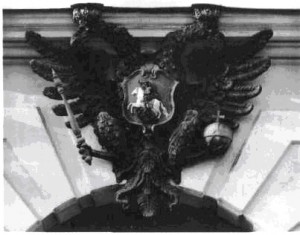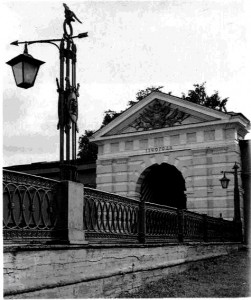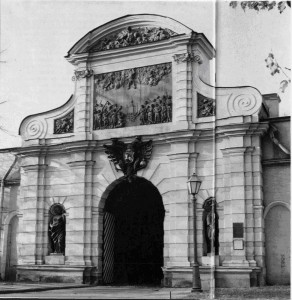Passing through the St John Gate into the ravelin of the same name, one’s attention is immediately drawn to the main gate of the fortress located in the centre of the curtain wall connecting the Tsar Bastion (on the left) and the Menshikov Bastion (on the right). Originally the main gate was crowned by a statue of St Peter; therefore, the gate itself, as well as the entire curtain wall in which it is located, have the same name – St Peter.
The St Peter Gate was constructed in 1717-18 replacing the original wooden main gate. Its appearance as a whole reminds one of Western European triumphal gates in the Baroque style as well as the main facades of Western European Baroque churches. The lower portion of the St Peter Gate is decorated with pilasters and rusticated masonry. Over a large arched opening is fixed a sculpture of the black two-headed eagle. On either side of the arch are statues of two women in niches (the one on the right clad in military attire; the one on the left wearing a long robe is holding a mirror and snake). Above this lower portion of the gate stretches an entablature, above which rises a richly decorated attic, consisting of a large rectangular wooden bas-relief bordered on either side by rusticated pilasters and volutes with smaller bas-reliefs, and topped by a curved pediment containing yet another bas-relief.
The bas-relief in the tympanum portrays Sabaoth encircled by angels, and the two bas-reliefs near the volutes depict various military attributes. The large rectangular bas-relief is a complex multi-figured composition. In the centre, on a cliff, stands a fortress; above it, amidst swirling clouds, winged demons are flying. A bearded man with wings is falling out of the clouds right down onto the fortress. Below to the right and left people are standing, some of them pointing at the falling figure. Near the fortress on one side a beardless man in the dress of a Roman military leader stretches his hand out towards the structure: on the other side a woman is kneeling before the fortress.
In the beginning of the eighteenth century the citizens of St Petersburg, undoubtedly, perceived this large bas-relief as an integral component of the entire gate decoration, including likewise the image in the tympanum of the pediment and the statue of St Peter, which crowned the gate at that time. To help explain the meaning behind the entire composition it is interesting to compare it with another extremely curious monument of Russian culture of that time.
In 1716 the St Petersburg Printing House issued a huge engraving, a panorama depicting the new Russian city on the Neva. In almost the very middle of the panorama the fortress is depicted with its main decoration at that time, the St Peter Gate. This engraving was presented in 1717 to Peter I, with a special explanatory text attached at the bottom, which was later titled Descriptive Laud of the City of St Petersburg and Especially of Peter the Great, the Creator of This City. The Descriptive Laud was compiled by the clergyman monk Gabriel Buzhinsky, an eminent writer of the epoch of Peter the Great, who, in particular, translated into Russian a great number of essays by Samuel Pufendorf, a noted seventeenth-century German Enlightener. The descriptive explanatory text compiled by Buzhinsky was given such great attention in the eighteenth century that Andrei Bog-danov, author of the first Russian description of St Petersburg, considered it essential to comment at length on the Descriptive Laud and to include it as a part of his book. As the Descriptive Laud reads, the fortress was put under the protection of Sabaoth and St Peter, and was founded “on the hard rock of piety” and “named St Petersburg”. The Descriptive Laud goes on to say that St Petersburg itself is also a rock, with which St Peter will strike all who attempt to encroach on the fortress, and that the “haughty Simon”, infuriating the great protector of the fortress, St Peter, “shall fall and be broken on the rock”; it reads further that St Petersburg has yet another “great protector” – St Alexander Nevsky (the canonized Russian prince, under whose command on July 15, 1240, the Novgorodians were victorious over the Swedes on the Neva). If one recalls that the Greek word petros has cognates in the form of the masculine name Piotr (Russian), Pieter (Dutch), and Peter (German and English), as well as a second meaning as a noun signifying a “rock” or “cliff”, then it becomes obvious why Buzhinsky in his Descriptive Laud continually associates “rock” with the names “Peter” and “St Petersburg”. The idea automatically comes to mind of the close association of the image on the St Peter Gate with the basic ideas of the Descriptive Laud. Taking everything into account, one can conclude that Sabaoth is depicted in the tympanum as the protector of St Petersburg, which is portrayed in the centre of the bas-relief standing on a cliff. The bearded man with wings is undoubtedly the heathen sorcerer Simon Magus, who, according to the ancient Christian legend, at first defamed St Peter and then, with the support of demons, in order to prove his superiority, attempted to fly; however, St Peter drove the demons away with a prayer and Simon fell to the ground in disgrace. The beardless man in the garb of an ancient Roman officer is, more likely than not, Peter the Great, although it is also possible that this is St Alexander Nevsky. The kneeling woman appears from all indications to be a symbol of piety.
Thus, contrary to previous suppositions, the sculptural bas-relief composition, decorating the St Peter Gate since 1717-18, is not a symbolic portrayal of the victory of the Russians over Sweden, but rather was designed as a “laud” of the new Russian city by means of visual arts, as a symbol of its invincibility. The sculptural image above the gate of the black two-headed eagle is cast in lead and weighs more than a ton. On the eagle’s two heads are the Imperial crowns; in his talons a sceptre and orb; on his chest the red shield with a coat-of-arms depicting a rider on a white horse struggling with a winged dragon. This is the Russian Imperial coat-of-arms (the so-called State Eagle); the shield with the image of a rider (St George) striking a dragon is the ancient coat-of-arms of Moscow. The Russian Imperial coat-of-arms acquired its present appearance in the second half of the nineteenth century, as here the rider in the Moscow coat-of-arms is turned to the heraldic right side (for the viewer to the left side). This turn was introduced only in 1856; before that the rider always faced left. The statues which originally stood in the niches have not survived, and when the present ones were installed is also unknown. Opinions vary as to whom these statues portray. There is one supposition that the statue of the woman in military garb represents Athena Pallas or Bellona, while the statue of the woman with the mirror and snake represents – Truth, Poliade or Minerva. It is believed that the architect who designed the St Peter Gate (the present stone gate as well as the previous wooden one) was Trezzini, that the large rectangular bas-relief was executed by the sculptor Hans Konrad Ossner, and that the small bas-reliefs on the volutes were done by the sculptor Nicolas Pineau. The rectangular bas-relief was created for the original wooden gate and was reinstalled in the new stone gate as well.
The shape of the attic of the St Peter Gate is reminiscent of the attic of the eastern facade of the Sts Peter and Paul Cathedral. A very interesting episode in the history of Soviet science and technology has close connection with the St John Ravelin and half-counterguard of the Menshikov Bastion. In 1932-33 this was the site of experimentation and workshops for the first Soviet laboratory to create and develop rocket engines – the Gas-Dynamic Laboratory of the Military-Scientific Research Committee. This laboratory became the basis for the Experimental Design Bureau, where high-powered rocket engines were created which launched artificial satellites into orbit around the Earth, Moon and Sun, as well as launching the remote-controlled spaceships “Vostok”, “Voskhod” and “Soyuz”, and delivering automated stations to the Moon, Venus and Mars. Today the half-counterguard of the Menshikov Bastion houses the Museum of the Gas-Dynamic Laboratory.




